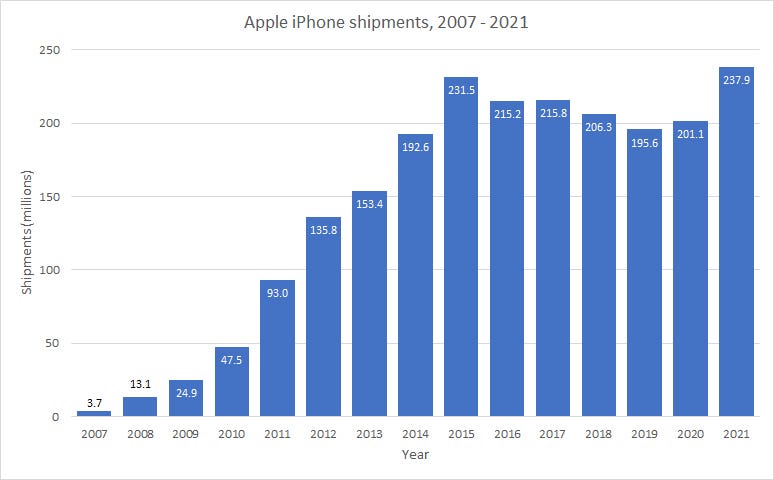At Apple’s “Far out” event this week, it’s virtually certain that Apple will unveil a new quartet of iPhones – the 6.1-inch iPhone 14 and iPhone 14 Pro, and iPhone 14 Max (or Plus) and 6.7-inch iPhone 14 Pro Max. Apple hopes that all of these devices will bring enough improvements to please those with the cash to spend.
After 15 years of existence (the first iPhone was launched in June 2007), one would expect the annual movement of the iPhone to slow down, at least a little.
But what I find remarkable is that there are no signs of this happening. If you’re not convinced, Counterpoint Research has just released some remarkable numbers: Apple shipped 237.9 million iPhones last year, an all-time high.

Data: Counterpoint / Chart: ZDNET.
iPhones now account for more than half of all smartphones in use
The iPhone 13 Pro and Pro Max took the top two spots in the list of best-selling smartphones in the United States (and Apple owns three of the top five spots including the iPhone 12). iPhone’s share of new sales peaked at 22% in the last quarter of 2021.
But there’s another data point that I think is even more interesting, and perhaps indicates Apple’s true strength. It is striking that although the iPhone is marketed as a premium product, it has recently achieved a 50% market share in the United States.
In other words, iPhones now account for more than half of all smartphones used in the United States, according to Counterpoint data shared with the FinancialTimes.
This installed base largely consists of second-hand smartphones
It’s not just about the flashy new models: this vast installed base includes old, battered but still functional phones, as well as devices passed down from early adopters to others after they bought a new version.
In short, this installed base largely comprises second-hand smartphones.
According to a recent study by CCS Insight, 1.3 billion smartphones will reach their first end of life in 2022. Half of them will be put away in drawers or thrown away. But an increasing proportion will be resold on the second-hand market. And Apple iPhones represent more than 80% of this “circular” economy, thanks in part to what CSS calls the “high residual value” of iPhones.
Apple is making more and more money from services
“Many smartphones from other brands have limited value and are often discarded or passed on to family members,” the research firm notes.
This second-hand market effectively creates another affordable on-ramp into the Apple ecosystem for people who might otherwise buy a mid-range Android phone. And that’s good news for Apple, which is making more and more money from services and hardware (and with better margins). This is partly due to Apple’s policy of supporting its phones with software updates for several years, which means that even phones that are five or six years old can still be viable devices, at least for less intensive use.
The new phones keep the momentum and energy going, and bring the new features to early adopters. But it’s this long tail of older devices that really demonstrates the power of the Apple ecosystem.
Source: ZDNet.com
